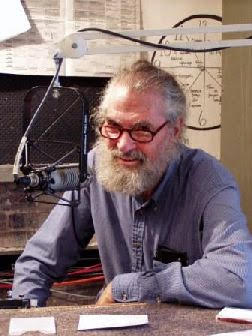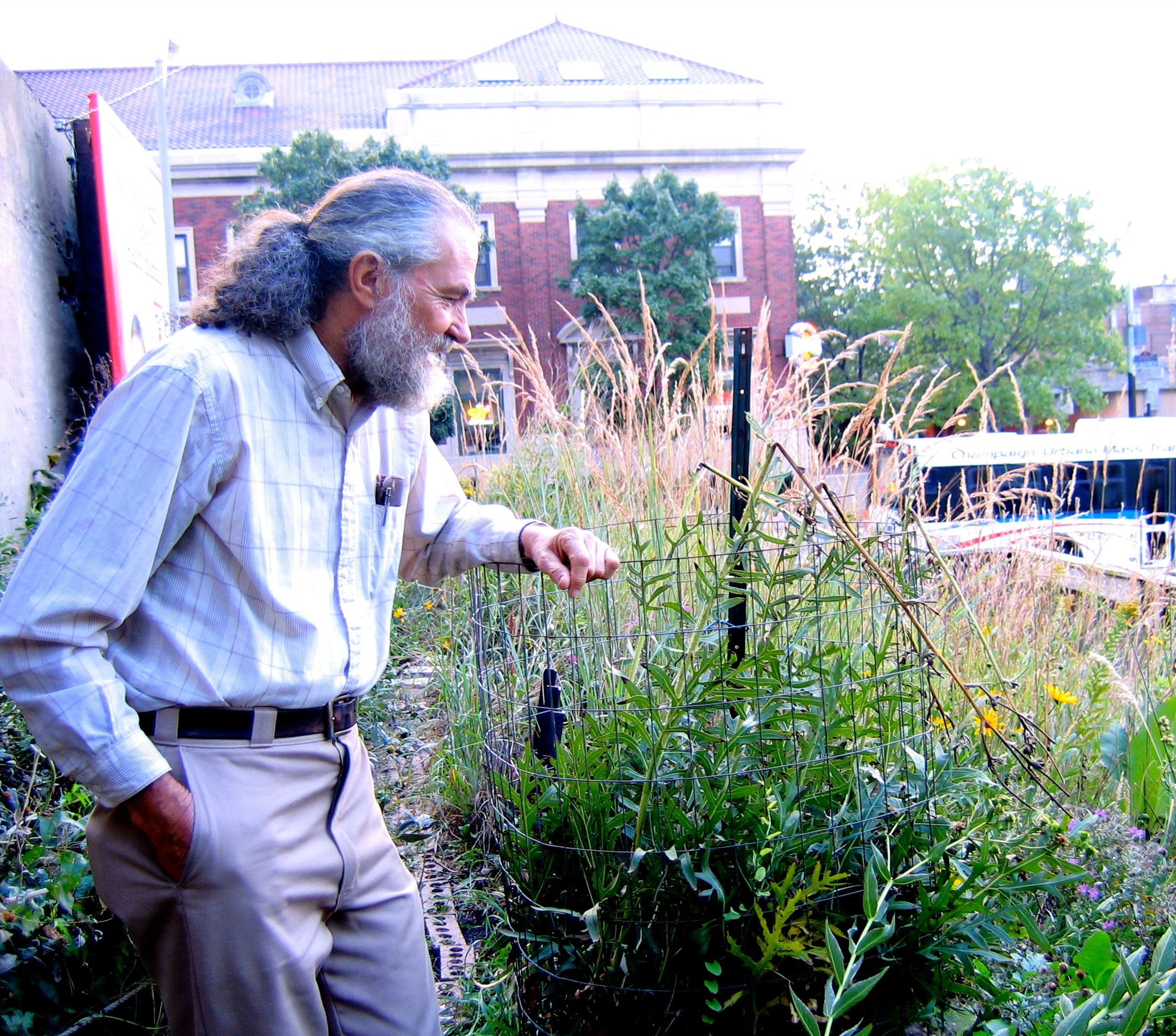
Dave Monk established the “Pocket Prairie,” across the street from the WEFT 90.1 FM studios on Market Street in downtown Champaign, in the 1980s; due to development of the space, it has been relocated to the Second Street Detention Pond area, south of University Avenue. He has been doing the Prairie Monk radio hour on WEFT 90.1 for over 30 years. I spoke to him at the Pocket Prairie site on the evening of May 25, during its last days. The interview has been edited for space reasons; the full version is available here.

Rick Esbenshade: You’re originally from Australia. How did you come to be in Champaign, and how did you get come to be interested in the local flora and the local landscape?
Dave Monk: I had been teaching at a community college. I came here in ’61, and was with the university for a while and I worked with a university project and with the curriculum lab, and we did things that people felt were interesting with the environment, the environmental movement was starting then. I was very interested in the ecosystem because I couldn’t find it when I came from Australia.
The only place where you found prairie was along railroad lines, which you weren’t supposed to dig up, and in cemeteries that weren’t looked after. I realized that this was an ecosystem that wasn’t understood and it was fairly rare. So I got involved and then we started buying up old railroad beds because that’s where the prairie was.
RE: So you would buy a whole stretch of track?
DM: Yes. In the Monticello area we have 33 miles. And it’s rails, trails and greenways, so it can act as a trail on the ballast that’s left, it can be rails if it wants to be rerailed, and we’re trying to do that, we’re trying to get historic trains from the railroad museum into Champaign. And greenways is the prairie preservation on the side. Champaign County was 94% prairie, there were hardly any trees; but people can hug a tree, they can’t hug a prairie. And prairie looks like weeds. And when I came to Champaign there were two 30-foot signs, and University Avenue which they were looking over is a federal highway, so you have a Lady Bird Johnson wanting signs to be smaller, and then they had to change to smaller and this left this area nice and landscaped, but weedy. So we just asked if we can get prairie here.
RE: And where did you get the plants here?
DM: Some of it comes from seeds, some of it comes from plants you dig up and bring. You grow little plots here and there and distribute them around to places that need to be restorated. So Lake Park has a two-and-a-half acre prairie. We have nine acres at Rantoul, which is adjacent to the railroad bed, and it has a remnant prairie on the main line, on what used to be an interurban railroad line, and on an old road. Our main effort is not to recreate prairies but to try and preserve what is left. Because we need to guess what was here at settlement time. So this prairie, the Pocket Prairie that we’re moving, was here mainly to introduce the prairie to people who didn’t realize what their heritage prairie was.

The “Prairie Monk” at the old Pocket Prairie location
RE: How big is the new site?
DM: We’re talking probably about half an acre here, and we have about the counterpart to that over there.
RE: So tell me something about the legal status of this space, it had belonged to the city?
DM: No, it’s never belonged to the city. Dr. Youngerman bought it. And there was this battle that shaped the piece of land where the advertising billboards were, and even if the building was occupied, this piece of land was not, and we felt like we could have our prairie there and have a trail around it, and it gradually grew.
RE: And so you asked permission from the owner, and he had no problem with it?
DM: Yes, he was quite in agreement, and it’s been like that for thirty-odd years now. But right now the building has been leased, they’re putting a million dollars into it to make it into a bar complex with apartments on top, and this will be a beer garden. So we were so grateful to have been here for thirty years, and now it’s well known. It’s a Pocket Prairie.
RE: So this building was empty for a long time?
DM: Yes, actually it’s been empty for a while, there’s been several attempts to use it. Downtown Champaign has gentrified. All around us are apartments, taxes going up, at some stage, we own one building and the taxes will eventually go up to the point where you might have to leave.
RE: You mentioned gentrification. Why don’t you talk a little bit about the history of the street here. I heard you on your show talking about that it had a rather checkered history in the past, I guess this was starting in Prohibition?
DM: The brick street we have on Market Street was an area that was bars, and theaters, you didn’t have movie places and so entertainment was often theaters, sometimes it was like the Virginia Theater, you had a proscenium stage that was narrow and you could have a team of young ladies kicking their legs up and doing interesting things. And they had bars, and starting price betting [on horse races], and various activities where it had a front that might be a coffee shop or something that was more mundane, but the walls inside, upstairs might be betting boards, and some of those are still there.
There was an East-Central mafioso, related to Chicago, and there were speakeasies. And there are places where there have been a bullet or two, and there have been brothels, and various activities where it was obvious that people were paid off, and this was what you enjoyed, and it was part of the fun of that era. In 1956, the Grubb family bought these buildings, so they had artists, they had engravers, they had printers. And gradually they closed out because the industry was changing, and then you had offset press, and now you don’t even have the press. The News-Gazette has sold their press and they produce their paper in Peoria.
RE: So then the street became kind of emptied out or quieted down?
DM: Yes. At some time there was a modification of Market Street. There was a lawyer building. And that has changed too now, I think they have about 20 artists in the Lincoln building now. So things have changed, and the building that’s behind you may become an apartment, and we’re trying to say that it not be a modern apartment but keep the character of downtown Champaign and especially of Market Street.
RE: Back to the rails, are you looking to buy more rail areas?
DM: Yes, we would love to buy a little piece of perhaps seven or eight or nine acres at Rantoul, which is farmland at the moment. So I would like to do a Kickstarter, if I got game enough, and I’d have to have enough people who are interested. And that’s part of what we’re doing here with moving the Pocket Prairie, is encouraging people to be involved. We need leaders who’ll be able to deal with twenty young people who don’t know yet what their heritage is, you have to be a little crazy to be involved, you have to have a passion for it. And so all this has to be so that you can hand it to the next generation.
We initiated a Kickapoo trail, and that’s taking off. We’ve initiated other things, the Grand Prairie Friends, and a Natural Area Study Group that is still rolling. And most of those have been taken over by other people, they would have the capacity to organize people, to get people together, and do it much better than we could do it as an initiator.
You may see we work with prairie, but I’m also thinking about other ecological things in the Arctic, the Antarctic, Australia, India. So it’s much more general than the specific; we’re dealing with the specific, but we’re playing a piano that is broader.
RE: A final question, just back to the specific: what are your expectations for the new location? There won’t be as many people wandering by I guess, because it’s not located in a central area.
DM: Right, it’s going to be a different cat. But we have people in the city who are really wanting to see some nature, and nurture. So if you go to the “Big Dig,” it’s called—it’s actually the Second Street Detention Pond, and it has the Boneyard running through it but it has a big pond. The birds, ducks and the like, have found the pond, and so they breed there and they hybridize, but they stay in the pond. So the prairie that’s surviving is to the north, nearly on University Avenue, and that’s where we’ll put the prairie.
RE: Thank you for talking to the Public i, and we wish you the best of luck and commend your energies over the many years you’ve been working to preserve and care for the environment here.
